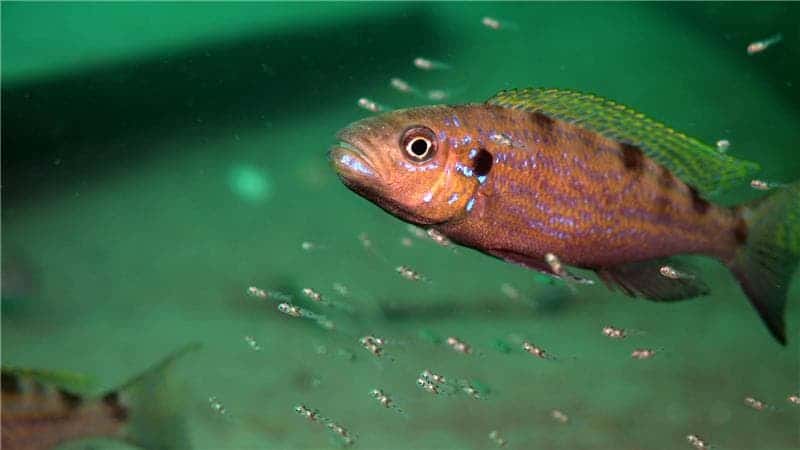Humans aren’t the only ones that exhibit handedness or a preference for one side of the body over another. Scientists have shown that many great apes and birds also exhibit this bias. Now, a team at the University of Konstanz, Germany, found an intriguing relationship between handedness, brain structure, and genes in the cichlid fish. Such investigation might teach us why and how some people turn left-handed or right-handed.

Cichlids of the Perissodus microlepis species endemic to Lake Tanganyika in Africa. Credit: Genome Biology and Evolution.
Cichlids (Cichlidae) are one of the largest families of fish with more than 2,000 known species of cichlids. One such species Perissodus microlepis, endemic to Lake Tanganyika in Africa, subsists on the scales of other fish which they prey upon from one side only. When this fish hunts it display a pronounced predilection for attacking their prey from one direction. What’s more, this predilection is mirrored by the shape of the fish’s head, exhibiting an asymmetrical jaw which is bent either to the left or to the right.
The team of Konstanz biologists led by Professor Axel Meyer documented the one-side preference of about 40 individuals, whose brains were thoroughly examined.
“We found a clear asymmetry across the animals’ brains, especially in the Tectum Opticum region of the brain. However, this asymmetry was present only in individuals who displayed a distinct preference for one side when hunting”, explained lead-author Dr Ralf Schneider, who is also a Konstanz biologist.
The tectum opticum is considered critical in enabling vision. In those cichlids that showed a distinct preference for hunting one side of their prey, the researchers found the corresponding Tectum Opticum hemisphere was more strongly developed than the other. Individuals that didn’t show a marked preference had far greater symmetry within the tectum opticum, as in other regions of the fish’s brains. This suggests that there’s a relationship between the shape of key regions of the brain and lateral behavior.
Later, the German scientists investigated gene expression across several parts of the fish’s brains. The analysis revealed patterns of expression asymmetry similar to the structural ones previously seen in the brain. In the tectum opticum region alone, for instance, as many as 140 genes showed differing activity in the two hemispheres, with gene activity being increased or decreased in the respective hemispheres. A particularly interesting result dealt with the gene synuclein gamma alpha (sncga) which previous studies on zebrafish have identified as having the predominant site of expression in the habenula — a part of the brain that is asymmetric in all vertebrates, including humans. Other genes associated with handedness, but also schizophrenia in humans, showed varying expression patterns in the brain hemispheres of the cichlids.
About one in ten people is left-handed and three percent are innately ambidextrous (can use both hands equally well). In 2015, Italian researchers found that a left-hand or right-hand predisposition was linked with body asymmetry. The present findings suggest that asymmetry is rooted in unequal gene expression in the two hemispheres. In vertebrates, some asymmetries in the brain could originate in the habenula.
As to why there’s such a thing as handedness in the first place, biologists say it would be a waste to have both hands work equally well. Such duplication would be unnecessary in terms of evolution. Concerning cichlids’ preference for feeding on scales from just one side of their prey’s body, this behavior probably evolved ‘side-specific’ development of gene regulation in their brains.
Scientific reference: Hyuk Je Lee, Ralf F. Schneider, Tereza Manousaki, Ji Hyoun Kang, Etienne Lein, Paolo Franchini, Axel Meyer. Lateralized Feeding Behavior Comes with Asymmetrical Neuroanatomy and Lateralized Gene Expressions in the Brain in Scale-Eating Cichlid Fish. Genome Biology and Evolution, published online on 24 October 2017.










